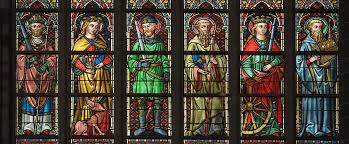There is a little-known, but very interesting book called John Who Saw by the English lawyer Adrian Howell North Green-Armytage (who must be deceased by now). It is admittedly a layman’s view of the Gospel of St John, and it is all the better for that. Since Monsignor Knox recommended it as having been written by someone he knew, there is a strong chance that Green-Armytage was Catholic. Certainly, it is a high intelligent book, full of common sense, and some real insights. Although it was published in 1952, I would suggest that 90% of its contents have stood that set of time better than contemporaneous academic works because it was offering an educated (indeed, a ferociously well educated) layman’s view, based on careful reading and logic – in other words, it eschewed the elaborate theories which make academic works date so quickly.
Green-Armytage’s main thesis is that simple one that the Gospel of St John was written by St John the Apostle, and that he was the beloved disciple who reclined on the breast of the Lord. This is the traditional view. It is a sign of how far scholarship has moved into what we might call a “hyper-critical mode” that this should be the decidedly minority view, and by itself, a badge – usually an accurate one – of being a Christian of some evangelical or arch-traditionalist variety.
The entire book (except for a few text critical pages) is a straightforward no-nonsense proposal that the traditional view makes sense and accords with all of the evidence better than any other. His subsidiary thesis is that the academic perspective on John (and the Gospels) is too theoretical. Speaking of a tortured and torturing biblical criticism “mainly in Germany”, but now almost everywhere, he wrote that they: “… serve as awful examples of what can happen when an over-zealous scholar treats his subject-matter on the lines of a chess-problem or a mathematical puzzle, without reference to the ways in which real people behave in the real world” (138-139).
What he means is this: the mental world of the scholars is not the real world in which most people live, but an artificial one in which reality is ignored. For example: “In my (Green-Armytage’s) world, if The Times and the Telegraph both tell one story in somewhat different terms, nobody concludes that one of them must have copied the other, nor that the variations in the story have some esoteric significance. But in the world of which I am speaking (the academics’ world) this would be taken for granted. There, no story is ever derived from facts but always from somebody else’s version of the story” (12).
So basically, there are two opinions in this book: the positive one of who did write the Gospel, and the negative one of the problems with the “higher criticism.” The book is of moderate length and tremendously well-written. Let us look at one of the most important aspects of it.
In my view, the critical issue, the fundamental one, is Green-Armytage’s treatment of the question whether the Gospel is true, and whether the symbolic nature of some of its contents does not show that it is not meant to be literally true. His argument is basically this: it is because it is a true story that its symbolism is worth taking note of. He notes the opinion of von Hugel (an influential modernist Catholic layman, 1852-1925) that the Gospel of St John, especially in its speeches, is an inspired fiction, providing symbol teaching of something deeper than the surface message (55). In reply, Green-Armytage states the St John’s intentions must have been “those of an ordinary, honest historian” (55); and how refreshing it is to think that the average historian is – or at least was – honest. But those were the days before historians were taught that there is no real historical truth, other than what they are pleased to make.
As Green-Arymtage points out, I think correctly, the whole point of St John’s Gospel and above all of his First Epistle is to tell Christians that their faith is indeed historically true (55). He then makes the powerful point: “Of course he thought Our Lord’s life was symbolical, that every detail of it concealed some profounder meaning, but for him the whole of that symbolism, that divine allegorical aptness which he valued in the life of Jesus, depended for its force on its historical truth” (55-56).
Let me repeat that, because it is critical: what Green-Armytage is pointing out, entirely correctly, is that the symbolism is worth taking notice of because of the historical truth of the facts in which the symbols appear. Without this, what does one have? Precisely the fiction of von Hugel and the modernists. To this, of course, the standard response will be: why should we care for your fiction and its symbolism any more than for another? Why not accept Hindu myth? Or the tales of the wandering singers of the wilderness? Or invent my own? Just as basically: if the story of the Lord and of the founding of Christianity is a myth, why not change it into a myth which better suits modern sensibilities? Or why bother with “modern” sensibilities, why not just remake it according my own fancy, and change it as I see fit?
Green-Armytage puts this extremely well when he says: “The allegory has no special force or authority if it be a mere human invention, like the fables of Aesop. Its whole value lie in its divine origin” (56).
The book is, as I said, quite short. You will probably not find it in any library, but it is still available on-line from second-hand bookstores. It is worth taking the time and trouble to purchase and to study it.
Joseph Azize, 13 August 2018
